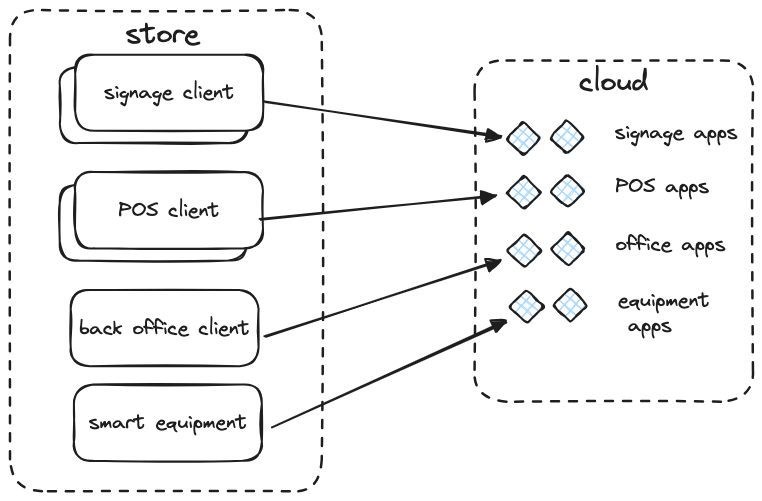2. Quick service restaurants
Edge use cases
|
|
Edge Computing is a shifting paradigm that enables quick service restaurants to offer reliable, secure, and fast services to their customers. As QSR businesses look to continue their competitive advantage and raise the service levels to customers, Edge Computing can be the ideal ally in achieving these goals.
Introduction
Edge computing enhances operational efficiency, provides real-time intelligence for decision-making, and greatly improves the dining experience and guest satisfaction —- ultimately increasing the bottom line.
Quick service restaurants (QSR) are under an immense pressure to innovate and differentiate their service levels for on-the-go customers. With consumer trends always shifting, COVID-19 driving change, and technology greatly advancing, QSRs are forced to reevaluate what is empowering their restaurant business and confirm what they are providing and accomplishing is the best to survive and succeed. So, how do QSRs best keep up and stay competitive in a constantly altering world?
The transformation of QSRs with edge computing
As the QSR industry becomes more digitally enhanced in its service offerings and operations, it is imperative that restaurant owners implement best practices with optimizing their operations, modernizing the dining experience, and employing better technological solutions to stay competitive in the marketplace. Not to mention the massive, detailed consumer data collected from IoT devices —- mobile ordering apps, POS systems, interactive kiosks, inventory software, smart security cameras, and more —- which often weigh down and max out the cloud capacity and capabilities.
As a result of the advances in technology, more and more quick service restaurants are adopting edge computing to support their restaurant modernization and growth needs. Not only does Edge play a critical role in enhancing operational efficiencies, providing real-time QSR analytics, and identifying new customer trends but makes it possible to further increase use of IoT devices, artificial intelligence (AI), and machine learning (ML) technologies.
How edge provides growth for the QSR industry
How the world dines on-the-go has changed. Paying on an app, ordering on kiosks, and automated curbside are now the norm. With these technological advances, cloud computing is being maxed out and cannot process the massive amounts of data nor meet all compute needs. QSRs are now moving compute power to the Edge. Here, data is collected, processed, and streamlined in unprecedented ways. Leveraging the Edge can also give forward-thinking QSRs the competitive advantage, particularly by providing real-time insights for a more personalized and optimized dining experience, the necessary data to build a more dynamic menu offerings, and the intel to create long-term customer loyalty.
Other key benefits of using Edge include reduced costs and latency, improved reliability, expanded data transmission bandwidth, enhanced compliance with jurisdictional requirements for security and privacy, and faster processing for VR, AI, and ML technologies.
Why edge matters
Edgecell’s Platform-as-a-Service (PaaS) is a proven tech-forward edge computing solution that enables QSRs to survive, thrive, and remain competitive while meeting today’s growing digital demands. By providing an innovative platform to process, analyze, and store data at the Edge, a plethora of services real-time insights and revenue streams are readily available —- smart kitchen data, scheduling and POS systems, self-service kiosks, inventory software, on-demand delivery, security monitoring, and more —- without an IT team and easily scalable from 100 to 10,000 locations.
Deployment patterns
Classic deployment
There is an explosion of technology in a typical QSR. There are complicated point of sale systems, smart kitchen equipment, dynamic signage, AI cameras and back of office applications.

Manually upgrading applications on premise with traditional deployment is very expensive and time consuming.
Cloud deployment
Many companies have tried to move some or all of these applications to the cloud. That has led to a lot of complications. If the network is down, the store cannot handle transactions. To overcome this barrier, POS vendors have created two versions of their application, one version that runs in the cloud and a less functional version that runs on premise.

Having IOT and AI applications run in the cloud also leads to complications. If the network is down, no data is captured or processed. It is also very expensive to move raw data, especially video to the cloud.
Edge deployment
An edge deployment gives QSR companies the best of both worlds. They have the reliability of on premise applications with the easy of cloud application deployment.

Each store has a highly available cluster of edge servers. All applications run in the cluster. Edgecell makes this deployment pattern possible.
